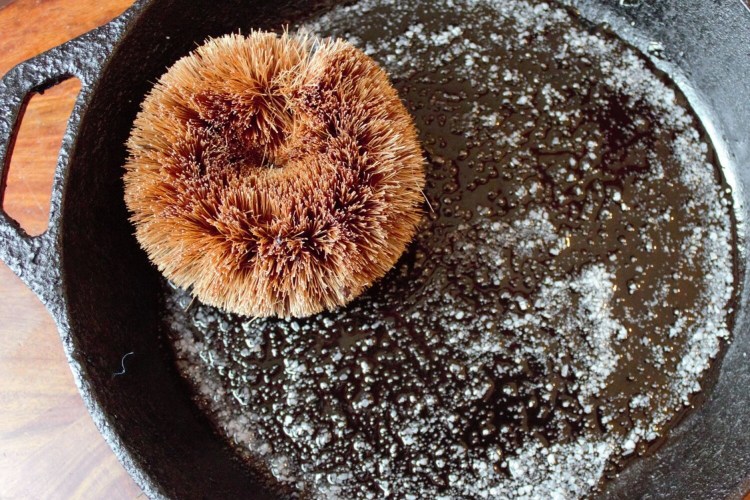I have bags of shredded, desiccated and flaked coconut in the basement freezer. In my fridge, there is coconut water. If my daughter isn’t here to drink after dancing, it makes a nice pot of flavored rice to put under spicy seafood. In my pantry, I keep coconut milk for curry and virgin coconut oil to make crispy vegan cookies. There is also (I expect less than virginal) coconut oil in the lotion I keep on my nightstand, the balm I put on my lips, and the shampoo stored in my shower stall.
I have coconut products, it seems, everywhere in the house except in the kitchen sink. Oh wait, I have them there now too!
Last month, when a friend and I were leisurely shopping in the curated home décor shops dotting Brunswick’s Maine Street, I was nonplussed when she presented me a two-pack of EcoCoconut scourers. Of all the lovely things on offer in these stores, she picks pot scrubbers to show her appreciation? “My sister gave me one of these the last time she visited. I’m giving them to you. They don’t have any plastic or toxins in them,” says my friend, an insurance lawyer who handles cases involving chemicals from PCBs to PFAS. “Use one, and pass one on to pay it forward,” she said.
I ask a lot from my pot scrubbers. They must work well with vegetable oil and salt to clean my cast iron pans. They can’t go irrevocably slimy after I’ve cleaned the bowl of the food processor I just used to make pie or pizza dough. They should certainly not damage my wares. And, they should, after finishing their nightly work in the sink, be presentable enough to sit on the counter in the background of a Green Place Special column photograph taken on most Thursday mornings.
Not only are they devoid of forever chemicals, these multi-talented scrubbies met each of my high demands. Like similar products offered by Earth Hero, Silkbon, World Market, and Zero Waste Club, these tools are made of coconut coir (pronounced coy-er). Biodegradable but sturdy, coir is a stiff, coarse but flexible natural fiber extracted from the outer husk of coconuts. Because it’s difficult to dye, products made from coconut coir typically come in only two colors – brown and white.
If you’re a gardener, you might have used coconut coir as a growing medium, as it both absorbs water and helps fight soil erosion. If you’ve walked through the garden on your way into the house, perhaps you’ve wiped your feet on a coconut coir mat. After a day of gardening, perhaps you’ve had a good night’s sleep on a mattress filled with the stuff.
Most coconut coir comes from India or Sri Lanka, according to a report published by the market research firm Coherent Market Insights. But researchers there say production is ramping up in the Asia Pacific region as demand for this eco-friendly material is expected to rise steadily through 2025.
As demand for coconut products grows, though, environmentalists worry that coastal mangroves – along with the ecosystems they support and the natural storm protection they provide – are being cleared for coconut monocrops. While you may want to consider cutting back on the amount of coconut water, milk and oil you consume to help prevent that, at the same time using coir-based products in your kitchen could help harvesters use every bit of every coconut felled for human consumption.
So buy a pair of coconut scrubbies soon. Keep one for yourself and pass one on.
Christine Burns Rudalevige is a food writer, recipe developer, tester and cooking teacher in Brunswick, and the author of “Green Plate Special,” a cookbook from Islandport based on these columns. She can be contacted at: cburns1227@gmail.com
Cool Coconut Creams with Rhubarb Compote
You likely won’t need a coconut coir scouring pad to scrub the containers holding these coconut milk desserts. Eaters tend to lick them clean.
Make 4 servings
1 packet unflavored gelatin
1 (400 ml) can full-fat coconut milk
7 tablespoons granulated sugar
1 vanilla pod, sliced in half lengthwise
1 pound rhubarb, cut into 1-inch pieces
Toasted coconut for garnish
Put the gelatin in a bowl and cover with 1/4 cup cold water.
Heat the coconut milk with 3 tablespoons sugar in a small pan over medium heat. Bring to a gentle simmer, then remove from the heat. Stir the bloomed gelatin into the coconut milk. Keep stirring until the gelatin dissolves. Pour mixture into 4 small glass dishes or dessert bowls, cool to room temperature, and transfer to the refrigerator to set.
Rinse the pan, combine the remaining 4 tablespoons sugar, 1/4 cup of water and the vanilla bean in the pan. Set the pan over low heat and stir to dissolve the sugar. Add the rhubarb and poach gently until softened but not mushy, 3-4 minutes. Cool to room temperature. Remove and rinse the vanilla bean for another use. Just before serving, spoon rhubarb compote over the coconut creams, garnish with toasted coconut and serve.
Send questions/comments to the editors.




Comments are no longer available on this story